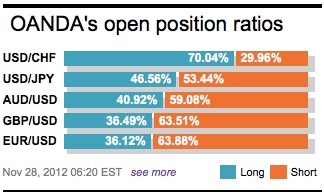Safe haven assets are once again the ‘flavor de jour,’ lifting the mighty dollar higher outright against the single unit while pushing global equities back into the red. US fiscal cliff concerns continue to depress global risk appetite and boost the demand for the off the shelf safer haven currencies. Asian and European bourses have been trading weaker, following in tandem yesterday’s late session fall in US equities in response to a comment from Senate Majority Harry Reid that he was “disappointed” with “little progress” in talks about resolving the US fiscal cliff.
Time is running out as capital markets approach the year-end turn when supposed US automatic tax hikes and spending cuts are being triggered. The US economy currently does not have the growth bandwidth to sustain such an economic move. Global growth is so tentative and that any such misalignment of new economic policies is in danger of pushing the US economy back into another recession, which would have global implications according to the OECD. Its no wonder that the day-to-day markets are so hyper sensitive to US economic talks or lack thereof! The roughened optimist continues to believe that a deal will be reached before the year end that will defer the bulk of the fiscal cliff and hence a deep economic fallout.
Even the shine of yesterday’s Greek aid package deal is wearing thin. Currency price movement over the past 24-hours just goes to show how much of this Greek deal had already been priced in. Investors this morning continue to move back towards the safety of the German Bund and away from riskier Euro-stocks. Economic data releases by the ECB this morning confirms that the contraction in Euro-zone credit appears to have bottomed out last month. The data released shows multiyear highs in key monetary aggregates.

The broad monetary aggregate M3 increased +1.2% in October, after declining -0.2% in September. Analysts note that the growth rate was the sharpest rate of growth in four-years. In annual terms, M3 happened to increase by +3.9% in October and this after the previous months +2.6% print. The three-month (August-October +3.9%) average remains below the ECB’s ‘reference value’ of +4.5% which policy makers deem appropriate with its price stability mandate of an inflation rate of +2% over the medium term. Private sector lending continues to leave a sour taste. It remains weak, declining by -0.7% in annual terms in October and this after falling -0.9% the prior month.
The average investor must expand their horizon and go far afield as the Philippines to find an economy that has become one of the most resilient economies globally. Data in the overnight session shows stronger than expected growth in Q3 (+7.1%), underscoring the successful move from a reliance on exports to keep their economy pumping to an increase in domestic demand. This pick up now puts the Philippines growth rate just behind China and in the lead for Southeast Asia. The results reflect the Philippines successful transformation into an ‘inward looking economy,’ something similar to what the Chinese government has been relying on to prevent any ‘cliff falling of their own’ occurring.
Analysts expect the Philippines current momentum to be carried through into next year, given the fact that the government has room to further increase consumer confidence by increasing taxes, reduce the country’s debt load and eventually garner that coveted investment grade credit rating. On the flip side however, an overly strong PHP could hurt export competitiveness and tourism, as well as weakening domestic spending power amongst the families of overseas Filipino workers. Like any economy, it will all depend on the government fine tweak the strong influencing variables.

For the single unit this morning, low volatility and multiple expires could confine the EUR to another ‘lame duck’ range. Despite the single currency remaining under pressure, the bears continue to run into Asian Central Bank demand as the currency outright approaches significant support levels. Profits have been happily booked along yesterday’s target line, which allows investors once again to look at reestablishing their core short positions at higher levels. Despite the 55-DMA looking under threat on the Euro-US handover, the hourlies are oversold and the market could be in danger of experiencing a small rebound. The ‘big’ picture indicates that the day charts have rolled over from overbought levels and that yesterday’s break above the psychological print of 1.30 now looks like a false one. The medium terms 21-DMA is now honing in on 1.2825-30 below.

Other Links:
EUR Surrenders after Benchmark Print
This article is for general information purposes only. It is not investment advice or a solution to buy or sell securities. Opinions are the authors; not necessarily that of OANDA Corporation or any of its affiliates, subsidiaries, officers or directors. Leveraged trading is high risk and not suitable for all. You could lose all of your deposited funds.



